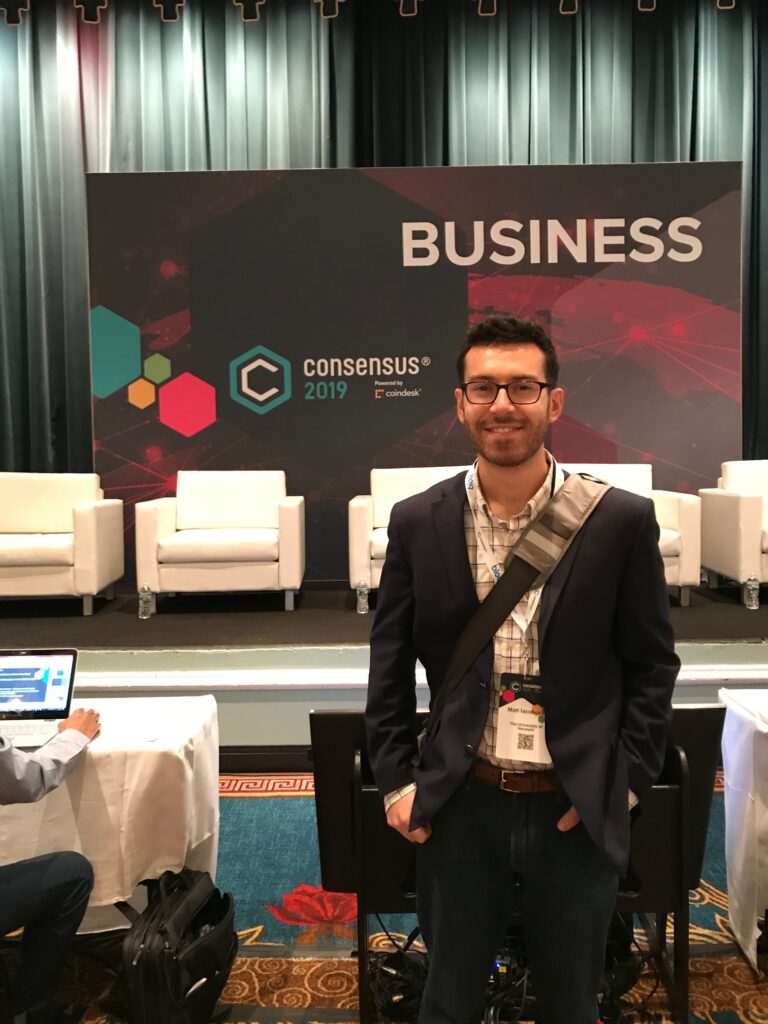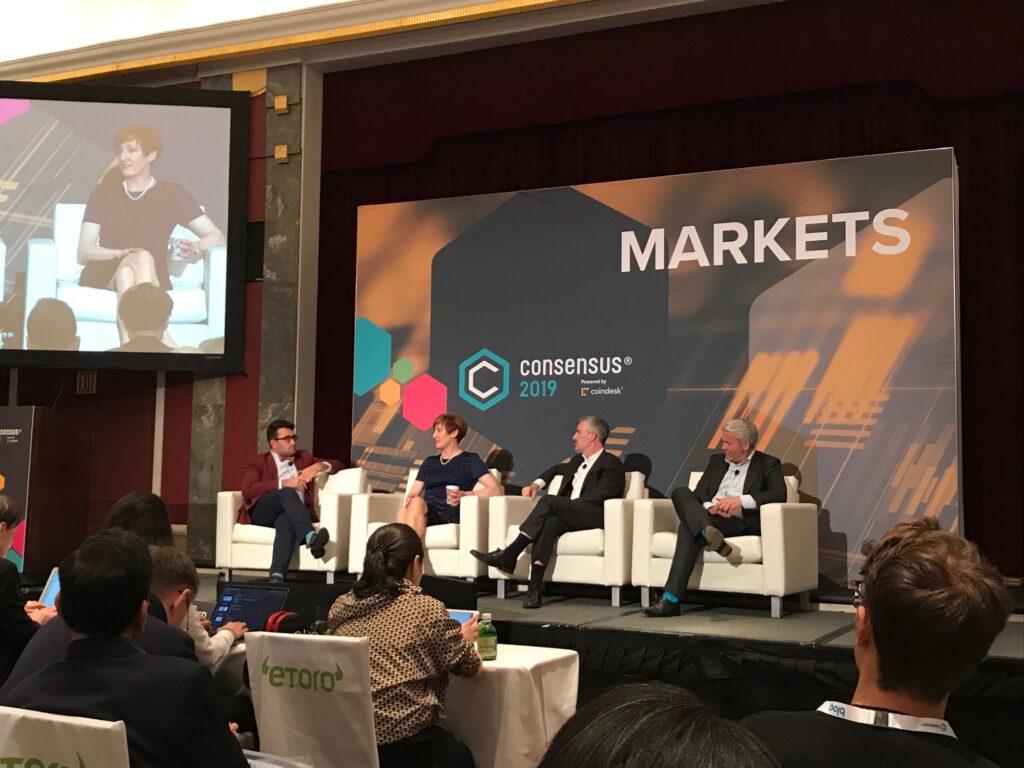This post was written by Matt Iacobucci ’19
Author’s Note: In our Sustainable Innovation MBA program, we talk a lot about sustainability! But for the purposes of this post, I’m going to focus the discussion on the “innovation” side of things. After all, in frontier market contexts where the opportunity to “leapfrog” technology exists, sustainability and innovation really do go hand in hand.

Last week I had the distinct pleasure of representing The University of Vermont’s Sustainable Innovation MBA program at CoinDesk’s Consensus 2019 Blockchain Conference in NYC. In attendance were founders of blockchain startup companies, software developers, institutional investors, regulatory agencies, blockchain journalists, and academics from around the world. The topics covered by keynote speakers, panelists, and facilitators of hands-on workshops were vast, and I could not help from allowing the imaginative techno-futurist within me dream of the type of social good that could come from a decentralized “Web 3.0.”
Before I lose my audience with heady predictions of a decentralized web future, I suppose I should first share why I attended this 3-day conference in NYC to begin with – that is, to expand my network within the blockchain development community and learn from industry leaders about how this new technology, blockchain (or “distributed ledger technology”), can be used in business to address the social and environmental challenges that exist today, particularly in frontier market contexts. And for what it’s worth, I’ll share with you what I see in my crystal ball later.
Wait Wait, Slow Down…What is Blockchain?
Put simply, blockchain, or “distributed ledger technology”, is a type of distributed database stored on a continuous ledger. Participants in a blockchain network can securely store their data on the continuous ledger such that no central authority or administrator can tamper with that data, adding the qualities of both transparency and immutability. This is where blockchain differs from a traditional database. At the end of the day, the real value that blockchain technology offers is trust.
Applied Learnings from Consensus to Practicum
This summer, I will be working with classmates Esteban Echeverria and Henry Vogt on a practicum project with local consulting firm Resonance Global. With a global presence in over 60+ countries, Resonance assists clients in deploying market-based solutions to unlock opportunity in frontier markets. My practicum team’s task for the summer is to develop a proprietary analytical framework for assisting Resonance’s clients to make better decisions about when and how to use blockchain technology in areas relevant to their work, and then expanding that framework to identify greater client opportunities for Resonance. As such, my attention during Consensus was primarily focused on seeking practical business use cases for blockchain technology as they might apply to solving problems in developing economies around the world.

The vibe of Consensus 2019 differed from last year in that there were “more suits and fewer costumes” among attendees (more on that here). Blockchain consultants from Deloitte, IBM, Tata, and Microsoft all had exhibit booths and lounges showcasing the practical applications of blockchain technology for industry. This year’s Consensus Magazine was titled “From ‘Crypto Winter’ to #DeFi: A Year of Loss, BUIDLing, and Opportunity”. While the ICO boom of 2017-2018 brought a lot of enthusiasm and startup capital into the blockchain and cryptocurrency space, it was clear that 2019 was to be the year of fundamental development, where applications for real business use cases will be piloted and scaled. As things turn out, this was great for me, one of the “suits” in attendance with an academic badge seeking to cut through the hype and learn!
I picked up a signed copy of “Blockchain for Business: Discover How Blockchain Networks Are Transforming Companies, Driving Growth, and Creating New Business Models” from Jerry Cuomo, IBM Fellow and VP Blockchain Technologies, where he penned “Matt – It’s a Team Sport!” I watched a luncheon video by Accenture showcasing its Tech4Good program, featuring its work with Grameen Foundation in economically empowering women at the BoP, among many other technology-driven projects for social good. I learned how ChainLink’s blockchain middleware application solves the smart contract connectivity problem by securely entering real world events onto the blockchain for seamless payments processing. I listened to Deloitte’s approach to advising clients on deploying blockchain projects from ideation to fundraising, structuring, building, and operating. I built my own simulated blockchain network on Amazon Web Services hosting platform in a 2-hour workshop session. Most importantly, I connected with several knowledgeable blockchain industry players with whom I can contact over the summer as my practicum team seeks the expertise needed to develop our blockchain framework for Resonance.
Crystal Ball Time: Blockchain and “Web 3.0”
Let’s take a brief walk through internet history. Remember when Al Gore invented the internet? Me too…(just kidding). Today, we can now look back on the internet era of the search engine, originally used for the sharing and distribution of academic papers, as “Web 1.0”: the Googles, Microsofts, and Apples of the world. Then came Mark Zuckerburg with “the Facebook” – insert “Web 2.0”, an internet driven by user-generated content, data collection, and digital marketing targeted towards an ever-more differentiated consumer who relinquishes data privacy in exchange for the service of algorithms directing her to exactly the right product or service in an increasingly mass-customization-driven market.
In a captivating panel discussion, futurist, economist, and writer George Gilder identified two key crises that represent an existential threat to continued prosperity: the collapse of internet security, and “the scandal of money” (I would personally argue for the climate change crisis to take precedent, but for the sake of carrying this conversation forward, we’ll keep the focus on “innovation” here). He epitomizes these two crises with the examples of the Facebook Cambridge Analytica scandal that undermined the power of democratic institutions in 2016, and the 2008 financial crisis where central banks intervened with monetary policy measures that arguably prevented a world economic collapse and maintained the status quo of power politics, respectively. All of a sudden, we realize the need for a new, decentralized digital architecture for the secure transfer and ownership of assets. Enter the “decentralized web”.
Bitcoin has captured the world’s imagination over the last 10 years in that it has made many of us rethink the very idea of money. While Bitcoin itself does not adequately meet any of the three requirements for money – a store of value, medium of exchange, and unit of account – it offers a new platform for value transfer in an increasingly digitized world. As Ethereum co-founder and founder of ConsenSys Joseph Lubin points out, the currency of the future is likely to be reduced to two things: data, and human attention. Lubin believes through this understanding that “we are going to change the nature of value”. The innovation that could bring this new conceptualization of currency into reality? Tokenization. Lubin points out that unlike Web 2.0, Web 3.0 will likely consist of several interacting, decentralized protocols on top of which more agile application layers will thrive.
So, what does the future hold? Is this whole cryptocurrency and tokenization thing just a fad? Can we digitize real world assets to fundamentally change how we perceive peer-to-peer value transfer? Will Bitcoin ever return to its 2017 high of $19,665? The heck if I know the answers to any of these questions, but after attending Consensus 2019, I am well convinced that blockchain technology will likely play a pivotal role in the evolution of technology towards a more secure and decentralized future, and the implications for social good to come of that future would be boundless.
